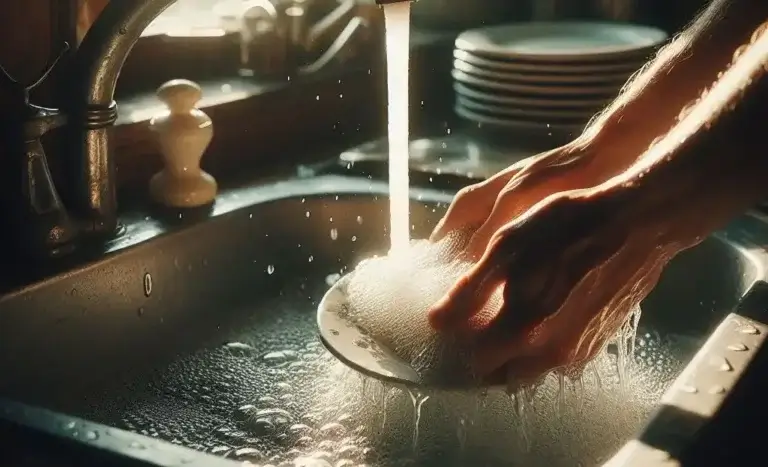How to Keep Dishwasher Drain from Freezing This Winter
Are you worried about your dishwasher drain freezing this winter? A frozen drain can stop your dishwasher from functioning properly and cause water damage if pipes burst when using the washing machine in cold weather. But there are things you can do to prevent your dishwasher’s plumbing from freezing even when temperatures dip below freezing.
In this comprehensive guide, we’ll cover everything you need to know to how to keep dishwasher drain from freezing. You’ll learn insulation tips, properly winterizing, and troubleshooting if your dishwasher drain does happen to freeze. We’ll also provide advice on how to safely thaw your frozen dishwasher plumbing for the faucet.
Follow these tips and you can rely on your appliance to cleanly wash dishes despite frigid winter temps outside. Let’s get started!
Table of Contents
Why Keeping the Dishwasher Drain from Freezing Matters
Newer dishwashers have built-in heaters and insulation that help to keep interior components protected. But freezer temperatures can still seep in through uninsulated drain lines and cause issues. Here’s why it’s important to take freeze-prevention steps:
- A frozen drain hose or water line stops water flow which prevents your dishwasher from filling and operating.
- Frozen water trapped in system components can expand and split plastic parts.
- Burst inlet hoses, pumps, and tubing lead to costly repairs and water damage cleanup.
- Preventing freezing is much easier than dealing with the aftermath of burst pipes and flooded kitchens.
Protecting your dishwasher’s plumbing requires only a small time investment before winter and some periodic checks. In return, you’ll have clean dishes all season without the cost or mess of frozen drain repairs.
How Do Dishwasher Drains Freeze?
Before covering winterization tips, it helps to understand how dishwasher drain parts end up frozen when temperatures plummet. All dishwashers have Drain hoses of washing machines need to be insulated as they may freeze. that remove wastewater from the unit during operation.
This drain line:
- Connects to the dishwasher’s drain pump.
- Runs from the pump along the back of the unit.
- Loops up to the sink’s or garbage disposal’s drain port.
This configuration leaves sections of the garbage disposal vulnerable to clogs. drain hose exposed underneath and behind the appliance. If your dishwasher resides next to an exterior wall or under a window, the ambient temperature around exposed parts drops considerably during subzero weather.
Prolonged exposure to frigid conditions can freeze residual water and food debris sitting inside the hose. Once ice completely blocks drainage, back pressure prevents proper water flow through the dishwasher.
Let’s look at tips tailored to the winter use of your indispensable cleaning appliance.
How to Keep Dishwasher Drain from Freezing This Winter: 10 Tips

Avoid untimely breakdowns and protect your dishwasher’s plumbing from the damage of frozen drains. Here are 10 useful precautions you can take before winter and during cold snaps:
1. Disconnect and Drain Inlet Hoses
Start winterizing by removing and draining the appliance’s water supply hoses:
- Turn off water shut-off valves behind the unit or under the sink first.
- Place towel beneath hoses to catch spills.
- Disconnect inlet hoses from water supply line ports.
- Hold hose ends over the sink and turn valves to drain any remaining water from the hoses.
- Once the water stops flowing, reconnect the inlet hoses loosely.
Disconnecting and draining inlet hoses eliminates freezing temperatures risk to the dishwasher’s water fill line.
2. Protect the Underside of the Unit
Wrap plumbing and exposed base:
- Cut sections of foam pipe insulation to fit around inlet hoses and drain hoses.
- Secure insulation pieces with electrical or duct tape.
- For extra protection, cover the entire underside base with an insulation sheet.
Encasing pipes and appliance bases reduces cold air contact that can freeze water inside plumbing.
3. Insulate Exposed Drain Hose
Prevent hose freezing behind dishwasher:
- Pull the unit forward carefully to access the clogged dishwasher’s drain hose.
- Wrap the hose from top to bottom with pipe insulation.
- For full coverage, encase an extra looped section of the main water pipeline.
Insulating the entire run of the drain hose keeps wastewater inside from dropping below freezing point during operation.
4. Seal Air Gaps Around Appliance
Minimize cold drafts entering the cavity:
- Place insulation pieces or towels along the sides of the cavity opening.
- Arrange bottom front insulation to seal any gaps under the dishwasher.
As an extra step – place a piece of rigid foam insulation behind the unit.
Filling in air gaps limits frigid air flowing around exposed drain hoses to help prevent freezing.
5. Check Door Seal Integrity
A dishwasher door that doesn’t seal well allows cold air penetration.
- Inspect the door gasket for any cracks or damage.
- Perform a dollar bill test by closing it on a paper edge protruding from the door.
- If you can easily pull the bill out, replace the old door seal right away.
Maintaining a tight door seal retains the interior warmth necessary for protecting components from freezing.
6. Run Appliance During Cold Snaps
Keep water moving within plumbing during sub-zero nights.
- Run full dishwasher cycle from late evening to early morning.
- Set the unit to air dry without heat option to minimize energy costs.
- Regularly run your dishwasher; doing dishes daily sustains water flow in drain hoses.
Letting water stagnate inside exposed drain pipes allows freezing when temps get extremely low.
7. Check Insulation Integrity
Ensure insulation stays arranged properly:
- Periodically confirm pieces underneath are intact and snug.
- Check door seal integrity by conducting a dollar bill test.
- Refit or add insulation if you find gaps or slack wraps, as pipes may freeze.
Keeping insulation sound guarantees continued freezing protection during sustained icy conditions.
8. Monitor for Freezing
Watch for signs of freezing drains:
- The dishwasher won’t fill properly or make odd sounds.
- Water on the floor around or under appliances.
- No drainage from the unit near the end of the cycle.
- Push the door firmly to check for frozen water inside.
Catching initial freezing symptoms allows quick thawing before extensive ice blockages develop.
9. Thaw Frozen Components
If you suspect freezing has occurred:
- Pull the dishwasher out to access the plumbing.
- Use a hairdryer on a low/cool setting to thaw ice gently inside the door.
- Wrap frozen drain hoses with towels soaked in hot water – swap out as they cool.
- Never use open flames or high-heat devices to thaw appliances.
Gradually warming frozen parts melts ice safely without causing damage from excessive heat.
10. Consider Installing Heat Trace Cable
For reliable protection from repeat freezing install:
- Water pipe heating cable rated for plastics alongside drain hose.
- Thermostat-controlled cable to operate only during freezing conditions.
- Have an electrician properly wire the power connection for the heater cable.
Heat trace cable keeps drain hose temperatures consistently above freezing all winter long.
What to Do If Your Dishwasher is Frozen

Despite precautions, a persistently freezing drain line or water inlet can still stop your dishwasher from operating a clogged dishwasher. Don’t panic – in most cases, you can unfreeze a frozen pipe yourself without a cost The plumber can help if the main water line gets frozen. visit.
Follow these steps to get your dishwasher functioning again after a freeze-up:
Open the Door and Let the Ice Melt
If there’s minimal ice buildup inside the appliance:
- Turn off the power to the dishwasher at the circuit breaker.
- Prop the door open and place towels inside the cavity to catch water.
- Use a fan blowing room temperature air to help melt ice gently.
- Check periodically and sop up melted water with dry towels.
Once the ice melts completely and no new water leaks, you can restart the unit.
Thaw Inlet Hoses
For a frozen water supply:
- Disconnect inlet hoses from the water line and sink supply valve.
- Submerge the frozen section of each hose in a sink filled with hot water.
- Massage hoses gently underwater as the ice melts.
- Once water flows freely, reattach the supply hoses.
Thawing inlet lines this way avoids needing to replace damaged hoses.
Clear Frozen Drain Hose
To unfreeze a blocked drain:
- Unlatch the dishwasher and pull out carefully to access the drain hose.
- Place hot, wet towels along the backside of the unit on top of the hose.
- Replace towels regularly until you see water flow resume.
- Disconnect the drain hose, hold over the sink, and run hot water through to flush the remaining ice.
- Clear any stuck debris before reattaching the hose.
Applying gradual heat melts blockages for normal drain performance.
Prevent Refreezing After Thawing
Once you get the appliance functioning again:
- Recheck insulation wraps are secure underneath and behind the unit.
- Let the dishwasher run to verify water flows correctly.
- Run appliance daily and inspect for new leaks starting.
- Consider rerouting or replacing drain lines if they freeze repetitively.
Sustaining drainage prevents the freed system from refreezing afterward.
FAQs: Preventing Frozen Dishwasher Drains
Winter weather questions on protecting your dishwasher arise often. Here are answers to some frequently asked queries on avoiding frozen drains:
Should I keep my dishwasher on all winter?
Keeping your appliance running daily sustains water flow to inhibit freezing and also provides efficiency benefits. Scrape dishes rather than pre-rinsing to conserve water if concerned about energy costs.
What temperature outside causes dishwasher lines to freeze?
Dishwasher parts can freeze anytime temps drop to near or below 32°F. Freezing happens quicker if cold winds directly contact exposed hoses underneath or if insulation is missing.
Where should I locate my dishwasher to avoid winter freezing?
Ideally, install the unit on interior walls away from exterior-facing cavities. Position appliances away from drafty windows or doors as well to limit icy air penetrating.
Can I use a space heater to warm my dishwasher?
Avoid using space heaters directly blowing on appliances due to fire risks. Strategically place the portable unit near the dishwasher aimed under the sink to mildly elevate ambient temperature instead.
Should I keep cabinet doors open in winter?
Leaving lower cabinet doors ajar helps equalize under-sink temperature to the ambiance in the room – reducing freezing likelihood. Just take care of open cabinets don’t create tripping hazards.
Conclusion: How to Keep Dishwasher Drain from Freezing This Winter
Preventing frustrated outages from frozen dishwashers Preventing drains from clogs requires some simple winterizing forethought. Prepare your indispensable appliance before cold weather sets in by insulating all exposed plumbing parts adequately. Then monitor closely as you continue running it daily to confirm water flows properly.
Remove any interior ice buildup promptly using low-temperature methods before thawing frozen drain lines. Relying on these freeze protection tips lets your dishwasher Handle piles of dirty cookware without issue despite icy conditions outdoors, use your dishwasher which might get clogged. Stay cozy indoors all winter long with clean dishes still coming out of a fully functional appliance.








